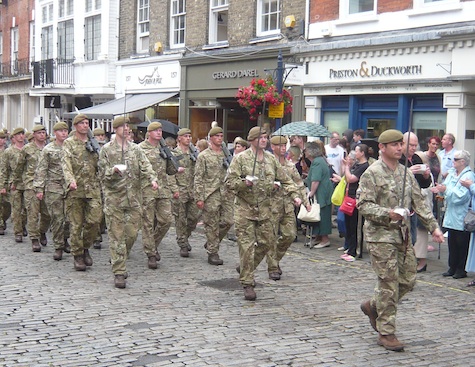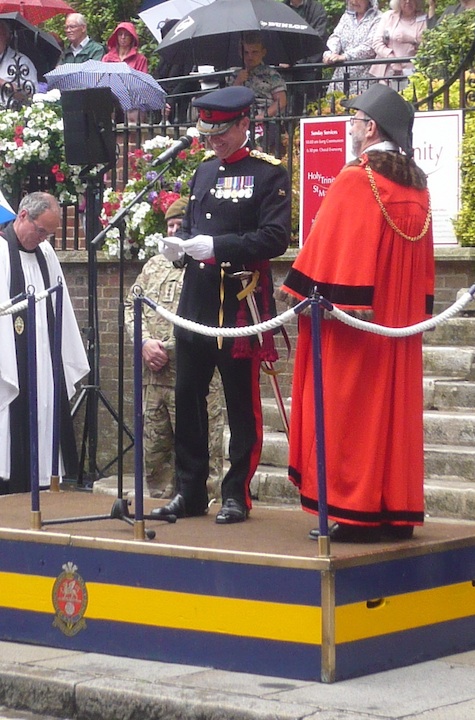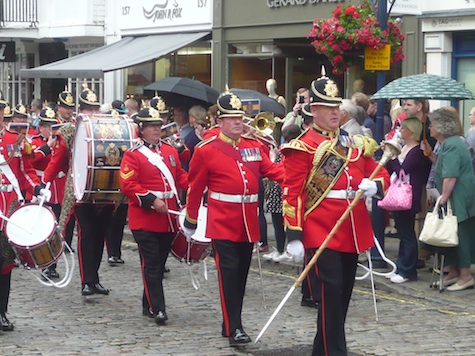 Abraham Lincoln
If given the truth, the people can be depended upon to meet any national crisis...
Abraham Lincoln
If given the truth, the people can be depended upon to meet any national crisis...
 Guildford news...
for Guildford people, brought to you by Guildford reporters - Guildford's own news service
Guildford news...
for Guildford people, brought to you by Guildford reporters - Guildford's own news service
Local Regiment Exercises its Right to March Through the Town
Published on: 29 Jun, 2014
Updated on: 2 Jul, 2014

The Princess of Wales’s Regiment marches up the High Street with band playing, colours flying and bayonets fixed.
Guildford’s local army regiment exercised its freedom of the town yesterday (Saturday, June 28) by parading in the High Street with bayonets fixed, colours flying and band playing.
The Princess of Wales’s Regiment (PWRR) is England’s senior line infantry regiment. A predecessor, the Queen’s Royal Regiment, raised in 1661, used to have its depot at Stoughton Barracks. It was granted the freedom of Guildford just after the end of the Second World War, and this civic right has now been inherited.

The colour party. Each regiment has two colours, a Queen’s Colour, here on the left, and a Regimental Colour. They bear the battle honours won by the regiment and are held in reverence as they represent the regiment’s spirit and all those who have fallen and served. In former time these would be the visible flags that the regiment would rally around on the battlefield. The PWRR colours have the oldest battle honour awarded in the British Army – Tangier 1662-1680.
Crowds gathered around Holy Trinity Church where the Lord-Lieutenant of Surrey, Dame Sarah Goad DCVO, JP and the Mayor of Guildford, David Elms, took the salute and inspected the 70, or so, soldiers on parade from the 3rd Battalion of the regiment.

One of the two divisions guarding the colours, led by the commanding officer of the 3rd Battalion, Lt Col John Baynham.
The parade comprising a band, a colour party, and two guard divisions, all commanded by Lt Col John Bagnham, marched up the High Street at 2pm to applause from onlookers.
After the inspection, a service, with prayers, a hymn (I Vow To Thee My Country) and the National Anthem, was conducted by Canon Robert Cotton. The parade was addressed by the Mayor who told the soldiers how proud Guildford was to be associated with the regiment and how impressive was their bearing and smartness their prowess was respected and feared throughout the world.
Colonel Patrick Crowley, a deputy colonel of the regiment, who as a boy was a member of the Surrey Army Cadet Force at his school St Peter’s in Merrow, responded by thanking the Mayor on behalf of all the troops.

Deputy colonel of the regiment, Col. Patrick Crowley who went to school in Guildford, replies to the Mayor.
He informed those present that many of the soldiers present had volunteered to be attached to regular battalions and carry out tours of duty in Iraq and Afghanistan and training in Kenya.
Fortunately for all present, the heaviest rain showers on Saturday fell just before and after the parade, which was watched by many Queen’s Regiment veterans as well as civic dignitaries.
A reception for the participating troops and invited guests was held afterwards in Holy Trinity Church.
Since the amalgamation of the Queen’s Regiment with the Hampshires in 1992, the resulting Princess of Wales’s Regiment has been known by the nickname The Tigers.
The regiment, which recruits from Surrey, Sussex, Kent, Middlesex and Hampshire, comprises three battalions, each of around 700 soldiers. The 1st and 2nd Battalions are made up of regular, full time soldiers and the 3rd Battalion of part time reservists.

Pte Dan Danario and Cpl Ali Kay, two soldiers from the regiment who come from Brighton. Cpl Kay has served in Afghanistan and Pte Danario has volunteered to do so soon.
The regiment came to national notice in 2005 when Private Johnson Beharry (now a sergeant) of the 1st Battalion was awarded the Victoria Cross for saving the lives of his comrades under fire. Pte Beharry was a driver of a Warrior armoured vehicle which was caught in two separate enemy ambushes in Iraq.
His story is included in the book Dusty Warriors written by the late TV military historian and author Richard Holmes who was himself was the colonel of the regiment from 1999 to 2007.
Recent Articles
- Guildford Institute’s Crowdfunding Project for Accessible Toilet in its New Community and Wellbeing Centre
- Letter: Guildford – Another Opportunity Missed?
- Letter: GBC’s Corporate Strategy – Where Is the Ambition?
- My Memories of John Mayall at a Ground-breaking Gig in Guildford Nearly Six Decades Ago
- Westborough HMO Plans ‘Losing the Heart of the Street’ Says Resident
- College Invests to Boost Surrey’s Economy and Close Digital Skills Gap
- Community Lottery Brings Big Wins for Local Charities
- GBC Housing Plan Promises ‘A Vibrant Urban Neighbourhood’ Near Town Centre
- Hospital Pillows ‘Shortage’ at the Royal Surrey
- Updated: Caravans Set Up Camp at Ash Manor School


Search in Site
Media Gallery
Dragon Interview: Local Artist Leaves Her Mark At One of England’s Most Historic Buildings
January 21, 2023 / No Comment / Read MoreDragon Interview: Lib Dem Planning Chair: ‘Current Policy Doesn’t Work for Local People’
January 19, 2023 / No Comment / Read MoreA3 Tunnel in Guildford ‘Necessary’ for New Homes, Says Guildford’s MP
January 10, 2023 / No Comment / Read More‘Madness’ for London Road Scheme to Go Ahead Against ‘Huge Opposition’, Says SCC Leader
January 6, 2023 / No Comment / Read MoreCouncillor’s Son Starts Campaign for More Consultation on North Street Plan
December 30, 2022 / No Comment / Read MoreCounty Council Climbs Down Over London Road Works – Further ‘Engagement’ Period Announced
December 14, 2022 / No Comment / Read MoreDragon Interview: GBC Reaction to the Government’s Expected Decision to Relax Housing Targets
December 7, 2022 / No Comment / Read MoreHow Can Our Town Centre Businesses Recover? Watch the Shop Front Debate
May 18, 2020 / No Comment / Read More












Recent Comments